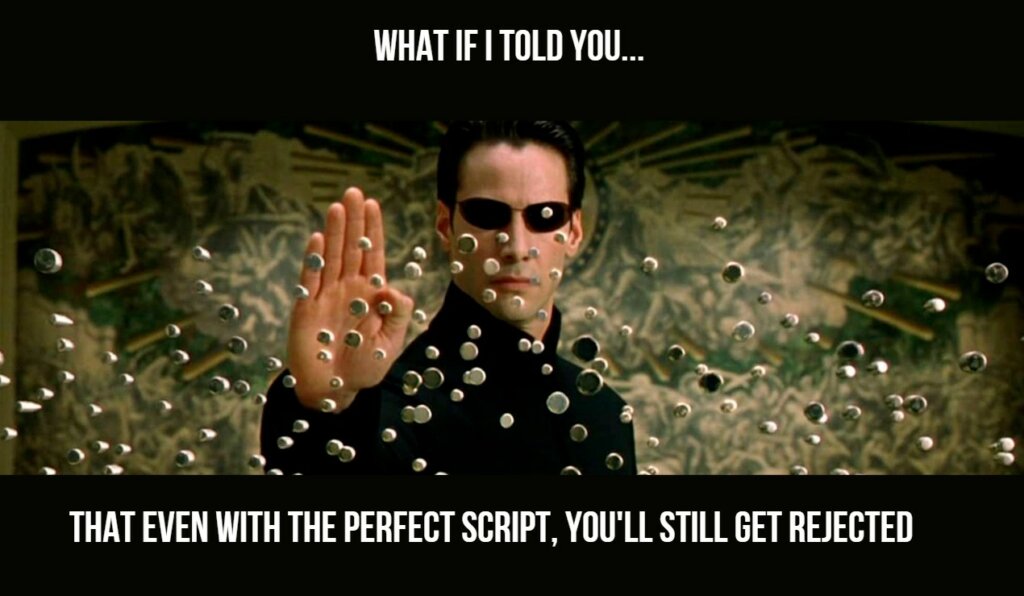Cold call rejections are no fun for anyone–and that includes the person doing the rejecting. For the salesperson, facing rejections can be tough on morale and hurt your productivity. For the company, a failed cold call is a waste of resources and one more step away from meeting revenue targets. Even for the prospect, hanging […]
Cold call rejections are no fun for anyone–and that includes the person doing the rejecting. For the salesperson, facing rejections can be tough on morale and hurt your productivity. For the company, a failed cold call is a waste of resources and one more step away from meeting revenue targets. Even for the prospect, hanging up (instead of listening for five minutes) is a missed opportunity to learn about new products and maybe improve the way they work. The good news is that there’s a lot to be learned from cold call rejection, and if you analyze it the right way, you can actually strengthen your position and closing rate.
Understand your target audience
It all starts with homework (said like any good teacher, right?). As successful salespeople know, a strong product and an effective pitch are only part of the equation– behind the scenes processes play a big part too.
Creating buyer personas
Hopefully, some of the leg work has already been done with a go-to-market strategy or a sales plan that details an ideal customer profile (ICP) – in other words, exactly who is most likely to buy your product. From that point, you should create buyer personas, which are a literal “personalization” of an ICP. Buyer personas describe the kinds of people who tend to be your customers and can include their role within the company, pain points, and expectations. With a few buyer personas at their fingertips, salespeople know where to start their research and find people to cold call.
Research and segmentation
Let’s say, for example, that you sell accounting software. You can use a third-party data provider to supply you with the names and numbers of accounting firms. But that’s not nearly enough. You’ll want to know which person in those companies is responsible for purchasing software, or else you could spend hours talking to admin assistants or other “gatekeepers” instead of the decision-maker. What you really want is to find contacts in the accounting departments of companies that fit the ICP and buyer personas. You’ll probably need a data enrichment tool that can add these types of details to basic contact data.
Now, if you’ve managed to find a good data enrichment company, you’ll get up-to-date lists of people who have varying levels of potential to become customers. At this stage, you can apply a lead scoring process to segment all of these prospects according to chance of conversion. (Pro tip: one added bit of information that can make this step even more effective is to use intent data, which tells you, in this case, if people at a target company have been recently searching online for accounting software).
Tailoring your pitch to match their needs
Almost done! – at least with the homework part, that is.The final move in understanding the target audience is to personalize your outreach. After all of that researching, scoring, and refining, hopefully you’re looking at a manageable number of prospects to call. But what do you say to them? Why would they want to listen to you? The answer lies in collecting a bit of tailored data for every contact, with a focus on pain points as discussed in the buyer persona. Some of the leading tools for researching prospects are:
With 900 million users, the world’s top business networking platform is a must-use for any sales professional. You can gain a lot of insight into a prospect simply by browsing their LinkedIn page. With LinkedIn, you can also send personalized messages, if you want to warm up that cold call
Website and blog
Through these assets, you can find out more about a prospect and the organization they work for. For individual contacts, use the About Us page to verify their position in the company and learn a little about their professional history. Similarly, blogs and website pages can teach you more about how well your value proposition matches the prospect. For example, if your accounting software is high-end, and you notice that the prospect’s clients are major multinationals, there’s a good chance that the prospect has a budget for your product.
To complete the picture, turn to Google. It might reveal valuable information likereports about the prospect company’s financial health or large deals in the making. On a personal level, you can search for mentions of the prospect in the media or additional professional information.

Prepare your cold call approach
Now that you’ve got specific information about the people you are going to cold call, it’s time to think about your presentation. There might be some leading sales pros out there with a totally original formula, but generally, a cold call is structured with four components: an opening statement, reason for calling, value proposition, and closing.
Crafting a compelling opening statement
Getting your foot in the door might be the hardest part, especially if you are trying to get through to a busy manager. Luckily, there are some fantastic B2B cold calling tips that include opening lines with surprisingly good success rates. These include “how are you doing”, “how are you”, and “the reason for my call is …”.
However, there’s another move that can make your first step easier, and that’s “warm calling”. A warm call is when sales has already been in touch with a potential buyer through things like a direct email or referral. Then contacts are actually expecting your call, which you can optimize by skipping a lot of the opening statement and getting straight to the pitch. The best part is that, because you know who you are calling, you can do a bit more research and have a strong idea as to the best value proposition for this person.
Scripting your call, but not too much
A successful cold call will involve creating some type of connection, although brief, with the prospect. But when you sound like you’re reading from a page, you’ll have the opposite effect. To get around this, adopt a “personalization cold calling script” using talking points based on customized messaging for each prospect. The framework of this script is:
- Opening line
- Name of company and the reason why they might be interested in your product
- Pain point and value proposition
- A leading question to encourage more conversation
Anticipating common objections
At some point during the conversation, the prospect may push back against your pitch or about your calling in the first place. The trick here is to answer any objection with a question. For instance, if they say that “now is not a good time”, then reply “OK, when would be better?”. Having such fast responses is a matter of:
Thinking about these objections before you call (and having a counter-question ready)
Asking other people on your team about common negative responses
Building up your responses by remembering the objections that you could not counter
Choosing the right time to call
The time you call can be almost as important as what you say once you get through. Everyone knows the feeling of being interrupted while doing something important at work. At the very least, it makes you less likely to want to listen. At worst, itcan even cause some people to refuse any more calls from you.
Thankfully, there are several best times to cold call:
- In the morning: 8-10 AM
- Near noon: 11 AM – 12 PM
- In the afternoon: 4-5 PM
But don’t take these times as a given. Each of your contacts will have a certain rhythm to their day. Diplomatically finding out when they’re more available for callscan work wonders… and should definitely be recorded somewhere in the CRM.
Learning from experience
There’s no getting around it, cold calling is a challenge. Even with all of the above tips, rejection is always going to be part of cold calling. But you can still reduce the number of rejections you get.Thankfully, because cold call rejection is such a common hurdle, you can find many ways to improve.
How to handle rejection in cold calling
The real barrier for a “cold caller” is attitude, so boosting yours is essential.
First, let’s define “rejection”. To clarify, rejection is an absolute no that comes even after you have made multiple calls (the average is eight) to reach a prospect (as opposed to dealing with objections – see above). And yes, rejection is bad. It can hurt your feelings and your numbers.
To better handle rejection, let’s remember that in this world, only three things are certain– death, taxes, and failures. There is no salesperson on the planet who is always successful. This is especially true when you look at cold calling statistics. For the inexperienced, you could be hit with a success rate of only 2%. So if you can’t avoid it (and to some extent, you can’t), then follow the Growth Mindset and learn from it.
Take a walk
One of the most practical moves to deal with cold-calling rejection is to take care of your emotional state. If you find yourself wanting to be anywhere but at your desk, then get away from it. Take a walk, do some stretches, get a snack (…not too often), listen to a favorite song, scream into a pillow, and come back ready for the game.
Talk to people
Both peers and managers will have ideas for you could do differently. Peers are a great sounding board because they’re going through the same challenges. On the other hand, your manager has both the experience and the responsibility to help you out, so look to them for valuable coaching advice.
Analyze call data for insights
Examine some of the objective facts of the calls you’e made, such as time of day, the pitch you used, or the role of the person you spoke with, and think about changing up these variables. Another option is to listen to a call recording so that you can hear your tone of voice and where the call went wrong (just know that it’s not always legal to record a call without the consent of the prospect).
Use CRM systems for personalization
During the research stage, you collected information about prospects and maybe added it to a CRM. Is there something you missed in the CRM records that could help with the all-important personalization aspect of a cold call? Is there additional data that you’d like to see? You’d be amazed at how much data an enrichment service can provide so that you have more profile categories to use to customize a call.
Key takeaways
- To optimize cold calling success, you should research prospects, create personas, and customize your pitch.
- When actually cold calling, make sure you call at a good time, work on your opening line, use a personalized script, and answer objections with a question.
- To deal with unavoidable rejection, take a break and then ask for advice while analyzing your calls and making the most out of CRM data.

